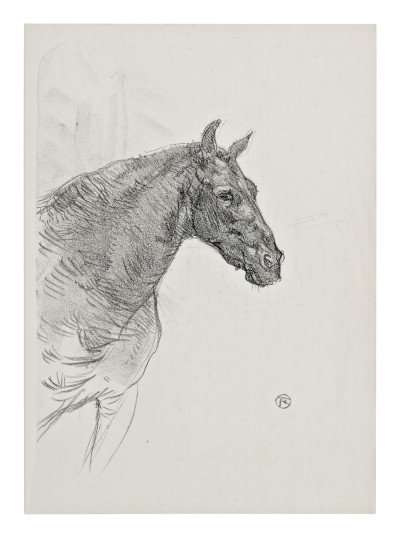Philibert the Pony (Le poney Philibert) was a design produced by Henri de Toulouse-Lautrec in 1898. It would be turned into lithographic prints, with fifty copies made in total.
In front of us we find the front of a horse, with considerable detail being added to its facial features. The artwork is stamped in the bottom right in order to signify its correct attribution. The elements of the face are carefully and precisely added, with contoured lines bringing this creature to life. This can be considered a completed piece, where as some of the artist's other drawings were actually much more brief and lighter in tone. As Toulouse-Lautrec increased details he would go over the same lines several times, making them darker and more pronounced. He places the head within the centre of the composition, with its neck leading off to the left. The rest of the paper is left completely blank. It is a stunning portrait of a pony named Philibert and continued this artist's interest in portraits of horses which began from an early age.
Many of the lithograph prints still exist today, some of which can be found within prestigious art galleries and museums, such as the Chicago Art Institute, for example. Their own entry is listed as having been produced on ivory wove paper and they detail the catalogue raisonnes for this artist in which the piece has already been included. Another copy went for sale as Sotheby's in 2020 and sold for $13,750, which fell within the pre-auction estimate. By contrast, they believe that only around thirty copies were made. The artist used lithographic prints as a means to advertising certain clients as well as making his work more accessible to those with smaller budgets, which in turn allowed him to expand his personal brand and ensure more people became aware of his work. Many artists have used the print medium for this purpose, dating back centuries before.
There are a large number of drawings and lithographs by the artist that appear for auction everyone once in a while within the US and Europe, with valuations remaining strong. Interest in his career is perhaps as strong as ever, and this timeless period in French art from the mid to late 19th century can be considered one of the most influential times in western art, with Toulouse-Lautrec playing an important role himself. Exhibitions of his work continue to appear too, and publications on his life are also fairly regular, though sometimes focusing on his connection to other big names in the art world as well.




